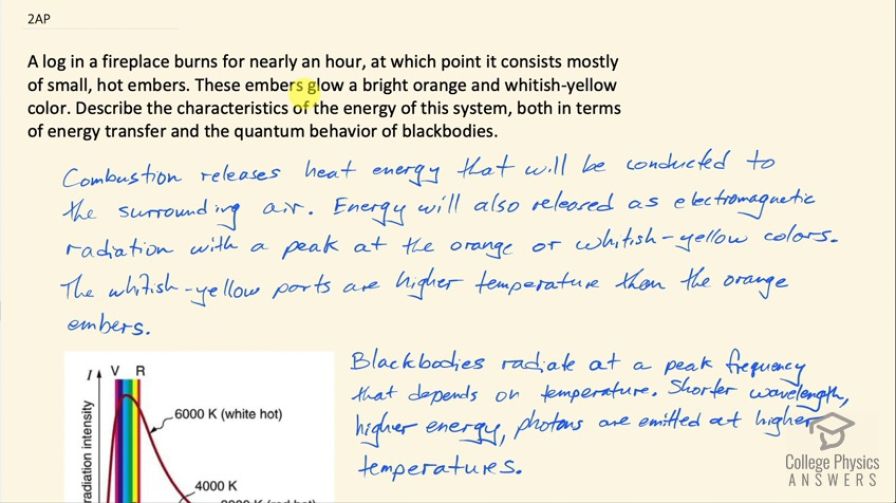Question
A log in a fireplace burns for nearly an hour, at which point it consists mostly of small, hot embers. These embers glow a bright orange and whitish-yellow color. Describe the characteristics of the energy of this system, both in terms of energy transfer and the quantum behavior of blackbodies.
Final Answer
Please see the solution video.
Solution video
OpenStax College Physics for AP® Courses, Chapter 29, Problem 2 (Test Prep for AP® Courses)

vote with a rating of
votes with an average rating of
.
Video Transcript
This is College Physics Answers with Shaun Dychko. We imagine that a log in a fireplace burns for about an hour after which it is mostly hot embers and these embers glow a bright orange or whitish-yellow color and we are meant to describe the energy of this system in terms of energy transfer and quantum behavior of blackbodies. So we imagine that the coals are blackbodies and when you say blackbodies, it just means ignore, you know... some materials have a property called emissivity, which means that they will naturally absorb or resist emitting certain wavelengths just because of the type of material and we are meant to ignore that affect. So these coals we are meant to approximate as blackbodies which is to say that they emit on all wavelengths or they absorb all wavelengths and this emission is entirely due to its temperature. Okay! So combustion is releasing heat energy that will be conducted to the surrounding air and energy is also going to be released as electromagnetic radiation with a peak at the orange or whitish-yellow colors and the whitish-yellow parts are higher temperature than the orange embers because we can look at this blackbody radiation intensity versus wavelength graph so it's showing that short wavelengths will have a greater intensity emission when there's a higher temperature. So at 6000 Kelvin, we have this curve here which has a peak in the blue area and has a pretty even distribution of all the visible colors, in which case this would be white whereas the orange embers are probably about 4000 Kelvin because there's a lack of violet and blue whereas there is lots of red and yellow and green and so this might together all make a bit of orangy color and other parts cooler still might be a bit red so there is not very much green or yellow involved in the emission. So the peak frequency here depends on temperature and shorter wavelengths have higher energy and those are emitted at higher temperatures.